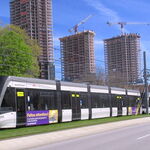Bordercollie
Senior Member
So about 45 minutes faster than the trip today...
So how do you make the schedule reflect the original schedule before the track deteriorated? Shouldn't they be able to shave an hour off that trip?
With 95 mph speeds, 2hr 40 mins or lower could be possible?Yep, 59 minutes. Here's how that would look for the morning trip.
View attachment 371700
The 2021 column is the current (Oct 2021) schedule. The 2022 column is the schedule I think will be implemented soon, to reflect track improvements completed in Dec 2021. The 1976 column then swaps out the London-Kitchener travel times for the ones from the April 1976 schedules. The numbers between are the time savings between stations.
Apart from the segment between New Hamburg and Kitchener, the railway alignment is extremely straight. With track and crossing improvements, the speed limit could be raised a lot higher than the 70 mph (112 km/h) limit which was in effect in 1976. The alignment looks like it could easily support 95 mph (153 km/h) west of New Hamburg.
45-60 minutes faster. 2hr 50 minutes would be the potential time if stuff like Georgetown is also improved.So about 45 minutes faster than the trip today...
Yes. GO's current diesel bilevel stock operates at 150 km/h (93 mph) on Lakeshore West express services, and the 6 car consists used west of Kitchener have decent acceleration too. Furthermore the average stop spacing west of Kitchener is 30 km, which is triple the aforementioned Lakeshore West services.Does raising the line beyond class 4 (80mph) really do anything for Metrolinx, given the diesel-bilevels equipment likely deployed on the line for the foreseeable future,
This talk of raising the line speed above 70 mph is all under the assumption that Metrolinx or Via owns the line. I certainly wouldn't recommend doing any significant investment while CN still owns the line.setting aside the issue that it is further public capital investment (following VIA paying for signalling) in an asset the public neither owns or controls?
Apart from the segment between New Hamburg and Kitchener, the railway alignment is extremely straight. With track and crossing improvements, the speed limit could be raised a lot higher than the 70 mph (112 km/h) limit which was in effect in 1976. The alignment looks like it could easily support 95 mph (153 km/h) west of New Hamburg.
How much of a cost difference and time difference is 80 mph vs 90 mph? Class 4 vs Class 5A very reliable source tells me that the curve east of Petersburg is rated at 1 degree 30 minutes, and the curves just west of Petersburg are rated at 0 degrees 30 to 1 degree even.
By way of comparison, the curve on the Oakville Sub east of Mimico is also rated at 1:30, and express GO trains can do 80 through that curve.
- Paul
I'm sure that would depend on if it's new or you are rebuilding it.How much of a cost difference and time difference is 80 mph vs 90 mph? Class 4 vs Class 5
I wonder what the deal is with Georgetown. As far as I can tell, there's only about 0.35 mile of yard track, and the rest of the slowness is on bonded track built to mainline standards.45-60 minutes faster. 2hr 50 minutes would be the potential time if stuff like Georgetown is also improved.
I wonder what the deal is with Georgetown. As far as I can tell, there's only about 0.35 mile of yard track, and the rest of the slowness is on bonded track built to mainline standards.
View attachment 371793
Couldn't much of this be fixed just by tinkering with the signals? For example, letting westbound trains accelerate right after clearing the yard track (as eastbound trains do already), and signalling 25 instead of 15 mph when approaching it (as with the Bramalea stub track)?
I don't have current line speeds for that section of the Halton Sub, but the line speed in 2015 for that area was 50mph. Crossovers were all #20s, rated at 45mph. Considering how heavily the line is used, there's no reason to think that the limits have been lowered through there.I wonder what the deal is with Georgetown. As far as I can tell, there's only about 0.35 mile of yard track, and the rest of the slowness is on bonded track built to mainline standards.
View attachment 371793
Couldn't much of this be fixed just by tinkering with the signals? For example, letting westbound trains accelerate right after clearing the yard track (as eastbound trains do already), and signalling 25 instead of 15 mph when approaching it (as with the Bramalea stub track)?
The Kitchener business case estimated a 1h30 travel time from Kitchener to Union for the scenario with a CN-GO grade-separation, and 1h38 without a grade separation (for a stopping pattern with 9 intermediate stops, versus today's 6).With 95 mph speeds, 2hr 40 mins or lower could be possible?
I believe skipping Georgetown might save the most time if the main line track is used instead of the yard tracks. When I've used the train we spend 5 minutes getting into Georgetown and 5 minutes getting out.The Kitchener business case estimated a 1h30 travel time from Kitchener to Union for the scenario with a CN-GO grade-separation, and 1h38 without a grade separation (for a stopping pattern with 9 intermediate stops, versus today's 6).
So for a 2h40 travel time from London to Toronto with a grade separation, London-Kitchener needs to be 1h10, which is only 3 min less than in 1976. So that's definitely achieveable with a 95 mph limit (probably already achievable with 80 mph).
Without a grade separation, London-Kitchener would need to be 1h03, which seems like it would be doable with 95 mph limits, but I'd like to do at least a back-of-the-envelope estimate before making that claim.
In theory intercity trains skipping 7 stops would save about 14 minutes compared to regional trains (assuming 2 min per stop), but while the line is still single-tracked, the amount of time that can be saved west of Georgetown is limited by the passing track locations and in practice the time saved would be less. A rough scheduling exercise I did earlier came out with an estimate of 1h20 for VIA from Kitchener to Toronto regardless of grade separation.




